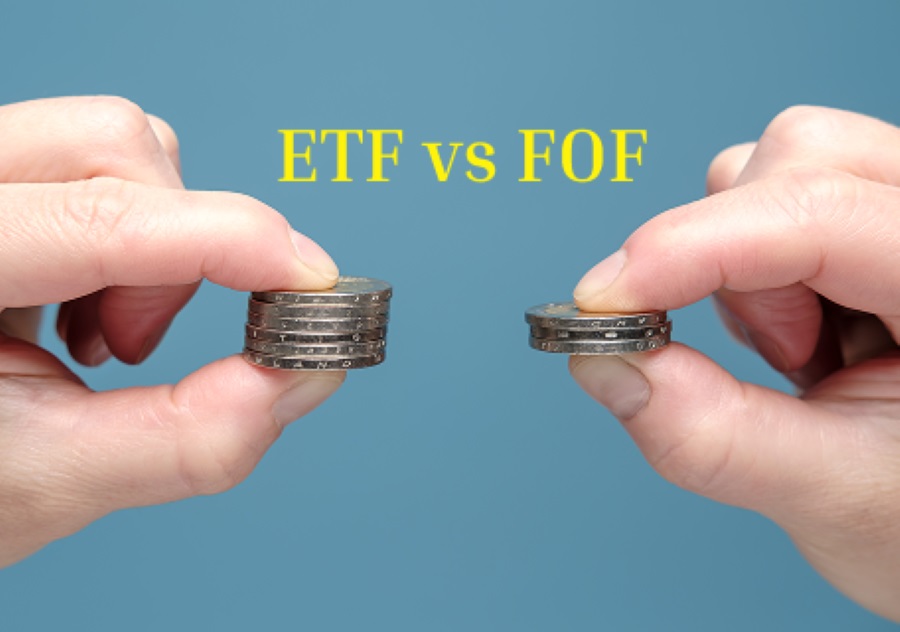Simplifying Life Insurance in India
Difference Between ETF vs FOF in Mutual Funds

Selecting the most appropriate investment vehicle is challenging when determining whether one should go with Exchange-Traded Funds (ETFs) or Funds of Funds (FOFs). Each investment vehicle provides some form of diversification and responds differently to different investor needs.
ETFs trade like stocks on an exchange. They are liquid and typically have low expense ratios. FOFs invest in multiple mutual funds managed by an organized investment team but generally charge higher fees.
Investors can more precisely value ETFs vs FOFs by determining their distinct differences. Read on to unravel those differences.

Table of Contents

What is an ETF?
An exchange-traded fund (ETF) is an investment fund that holds multiple underlying assets and can be bought and sold on an exchange, much like an individual stock. ETFs can be structured to track anything from the price of a commodity to a large and diverse collection of stocks.
ETFs can even be designed to track specific investment strategies. Various ETFs are available to investors for income generation, speculation, or hedging risk in an investor's portfolio.
What is an FOF?
The complete form of FOF is "Fund of Funds." These funds invest in various mutual fund schemes, and the investment portfolio may include schemes from different identical fund houses. The Fund of Funds is customized to meet investors' investment objectives and risk appetites.
A fund of funds (FOF) buys shares in other funds instead of a pool of securities like stocks and bonds. The fund-of-funds approach has grown recently, particularly among institutional investors like pension funds and endowments seeking to spread risk and maximize returns.
Key Differences Between ETF and FOF in Mutual Funds
Mutual funds feature two investment options named Exchange Traded Funds (ETFs) and Funds of Funds (FOFs). Determining the differences between these funds enables investors to make their selection. Here are some of the main differences between ETF and FOF:
Different Types of ETFs and FOFs in Mutual Funds
Types of Exchange Traded Funds (ETFs)
Types of Funds of Funds (FOFs)
How Taxation Works of ETFs and FOFs?
The tax treatment of Exchange Traded Funds (ETFs) and Funds of Funds (FOFs) differs based on asset allocation and holding period. Below is a brief comparison of their taxation:
ETF or FOF: Which is Better?
1. Cost & Expense Ratio
- ETF: It offers lower expenses because it applies passive index-tracking strategies.
- FOF: It has higher costs because multiple management fees are required to be paid to separate managers.
2. Liquidity
- ETF: Investors can purchase or sell ETF positions at any market time due to their high trading fluidity.
- FOF: FOF's liquidity remains lower when it executes trades based on mutual fund NAV pricing.
3. Tax Efficiency
ETF: ETF investments have tax savings because they create lower capital gain distributions than mutual funds.
FOF: FOF's tax efficiency is limited because it follows the debt/equity classification scheme for taxation.
4. Investment Horizon
- ETF: ETF is an optimal choice for investors seeking long-term investing at low costs.
- FOF: Long and moderate-term investors should consider FOF because it can handle diversified investments.
Factors to Consider Before Investing in ETFs and FOFs
After carefully going through the differences between FOF and ETF, take a look at the factors on which your choice for selecting between these two investment options will depend:
1. Investment Returns
An investor must thoroughly research and assess the investment strategy, asset allocation, and portfolio before investing in ETFs and FoFs. Your analysis must include understanding your risk appetite. If you are willing to receive higher returns, you may need to bear higher risks. Additionally, volatile investments also can make up for higher returns.
2. Profile of an Investor
You must ensure that your investment profile aligns with three pillars: investment objectives, horizons, and risk appetite. This is an essential parameter to check to maximize the benefits of investing in an ETF or FOF.
3. Portfolio Diversification
Financial experts suggest that investing in diverse asset classes lowers the risk in the investment portfolio. FOFs invest in different mutual funds. Therefore, they will extend a more diversified portfolio than ETFs. In addition, you can avail yourself of the benefits of expertise and guidance from multiple fund managers while investing in FOF. However, you can invest in an ETF if you want higher long-term returns over portfolio diversification.
4. Tax Efficiency
ETFs are generally tax-efficient as they involve lower turnover, leading to fewer capital gains distributions. FOFs, however, may attract higher taxes, mainly if they invest in debt-oriented mutual funds.
5. Risk and Volatility
Market fluctuations directly affect ETFs since they track indexes, making them more volatile. FOFs spread risks by investing in multiple funds, but their returns depend on the performance of underlying mutual funds.
6. Management and Control
ETFs are passive investments and require investors to monitor and rebalance portfolios themselves. FOFs, managed by professionals, relieve investors of active decision-making but come with higher management fees.
7. Liquidity and Trading Flexibility
ETFs trade on stock exchanges like regular stocks, allowing investors to buy and sell throughout the trading day. FOFs, being mutual funds, have lower liquidity and are subject to NAV-based pricing at the end of the day.
In conclusion, ETFs offer liquidity, lenses, and simple trading features. Conversely, FOF invests in several funds, yet their management expenses remain elevated.
Ultimately, your investment decisions regarding exchange-traded funds or funds of funds should balance your financial targets with your personal risk capacity.
Disclaimer: The information provided on this website is for general informational purposes only and should not be construed as financial, investment, or legal advice. While we strive to provide accurate and up-to-date content, we do not guarantee the completeness, reliability, or suitability of the information for your specific needs.
We do not promote or endorse any financial product or service mentioned in these articles. Readers are advised to conduct their own research, consult with financial experts, and make informed decisions based on their unique financial circumstances. Any reliance you place on the information provided here is strictly at your own risk.
FAQs about ETF vs FOF
Is opening a trading and Demat account to invest in FOF compulsory?
What are the types of ETFs available?
The following are the types of ETFs:
- Bond ETFs
- Commodity ETFs
- Gold ETFs
- Industry ETFs
- Inverse ETFs
- Currency ETFs
What is an ETF?
What is an FOF?
Which is better, ETF or FOF?
What are the types of FOFs?
What are the tax implications of ETFs and FOFs?
Is it reasonable to hold ETFs for the long term?
Which has a lower expense ratio: ETF or FOF?
Do ETFs or FOFs offer better liquidity?
Which is less risky: ETF or FOF?
Can I invest in ETFs and FOFs with a small amount?
Do ETFs and FOFs pay dividends?
Some ETFs pay dividends if they hold high-dividend stocks, while FOFs may reinvest or distribute earnings depending on the fund structure.
Other Important Articles about Mutual Funds
Disclaimer
- This is an informative article provided on 'as is' basis for awareness purpose only and not intended as a professional advice. The content of the article is derived from various open sources across the Internet. Digit Life Insurance is not promoting or recommending any aspect in the article or its correctness. Please verify the information and your requirement before taking any decisions.
- All the figures reflected in the article are for illustrative purposes. The premium for Coverage that one buys depends on various factors including customer requirements, eligibility, age, demography, insurance provider, product, coverage amount, term and other factors
- Tax Benefits, if applicable depend on the Tax Regime opted by the individual and the applicable tax provision. Please consult your Tax consultant before making any decision.
Latest News
Read More
















